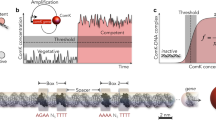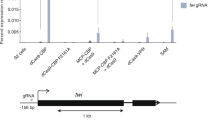Abstract
The activity of the yeast activator HAP1in vivo requires heme. A heme responsive domain of HAP1 was identified previously. It is adjacent to the DNA-binding domain, and appears to block DNA binding in the absence of heme. Here we describe a novel genetic selection which yielded mutants of HAP1 that are independent of heme when assayed for activation. These mutants define a second region of HAP1, close to the activation domain, which also controls its response to heme.
Similar content being viewed by others
References
Alani E, Cao L, Kleckner N (1987) A method for gene disruption that allows repeated use ofURA3 selection in the construction of multiply disrupted yeast strains. Genetics 116: 541–545
Creusot F, Verdiere J, Gaisne M, Slonimski PP (1988) CYP1 (HAP1) regulator of oxygen-dependent gene expression in yeast. I. Overall organization of the protein sequence displays several novel structural domains. J Mol Biol 204:263–276
Drygas ME, Lambowitz AM, Nargang FE (1989) Cloning and analysis of theNeurospora crassa gene for cytochromec heme lyase. J Biol Chem 264:17897–17906
Dumont ME, Ernst JF, Hampsey DM, Sherman, F (1987) Identification and sequence of the gene encoding cytochromec heme lyase in the yeastSaccharomyces cerevisiae. EMBO J 6:235–241
Fytlovich S, Gervais M, Agrimonti, C, Guiard, B (1993) Evidence for an interaction between the CYP1(HAP1) activator and a cellular factor during heme-dependent transcriptional regulation in the yeastSaccharomyces cerevisiae. EMBO J 12:1209–1218
Gronemeyer H (1991) Transcription activation by estrogen and progesterone receptors. Annu Rev Genet 25:89–123
Guarente L (1983) Yeast promoters andlacZ fusions designed to study expression of cloned genes in yeast. Methods Enzymol 101:181–191
Guarente L (1992) Messenger RNA transcription and its control inSaccharomyces cerevisiae. In: Jones EW, Pringle JR, Broach JR (eds) The molecular and cellular biology of the yeast Saccharomyces: Gene expression. Cold Spring Harbor Laboratory Press, New York, pp 49–98
Guarente L, Mason T (1983) Heme regulates transcription of the CYCI gene ofS. cerevisiae via an upstream activation site. Cell 32:1279–1286
Guarente L, Ptashne M (1981) Fusion ofEscherichia coli lacZ to the cytochrome c gene ofSaccharomyces cerevisiae. Proc Natl Acad Sci USA 78:2199–2203
Guarente L, Lalonde B, Gifford P, Alani E (1984) Distinctly regulated tandem upstream activation sites mediate catabolite repression of the CYCI gene ofS. cerevisiae. Cell 36:503–511
Haldi M, Guarente L (1989) N-terminal deletions of a mitochondrial signal sequence in yeast. Targeting information of δ-amino levulinate synthase is encoded in non-overlapping regions. J Biol Chem 264:17107–17112
Keng T, Alani E, Guarente L (1986) The nine amino-terminal residues of δ-aminolevulinate synthase direct β-galactosidase into the mitochondrial matrix. Mol Cell Biol 6:355–64
Kim KS, Guarente L (1989) Mutations that alter transcriptional activation but not DNA binding in the zinc finger of yeast activator HAP1. Nature 342:200–203
Mattoon J, Lancashire W, Sanders H, Carvajal, E, Malamud D, Braz G, Panek A. (1979) Oxygen and catabolite regulation of hemoprotein biosynthesis in yeast. In: Caughey, W (ed) Biochemical and clinical aspects of oxygen. Academic Press, New York, pp 421–435
Pfeifer K, Arcangioli B, Guarente L (1987a) Yeast HAP1 activator competes with the factor RC2 for binding to the upstream activation site UAS1 of theCYC1 gene. Cell 49:9–18
Pfeifer K, Prezant T, Guarente, L (1987b) Yeast HAP1 activator binds to two upstream activation sites of different sequence. Cell 49:19–27
Pfeifer K, Kim KS, Kogan S, Guarente L (1989) Functional dissection and sequence of yeast HAP1 activator. Cell 56:291–301
Picard D, Khursheed B, Garabedian MJ, Fortin MG, Lindquist S, Yamamoto KR (1990) Reduced levels of hsp90 compromise steroid receptor action in vivo. Nature 348: 166–168
Prezant T, Pfeifer K, Guarente L (1987) Organization of the regulatory region of the yeastCYC7 gene: multiple factors are involved in regulation. Mol Cell Biol 7: 3252–3259
Rothstein RJ (1983) One-step gene disruption in yeast. Methods Enzymol 101: 202–211
Sambrook J, Fritsch E, Maniatis T (1989) Molecular cloning: a laboratory manual. Cold Spring Harbor Laboratory Press, New York
Sanger F, Nicklen S, Coulson, AR (1977) DNA sequencing with chain-terminating inhibitors. Proc Natl Acad Sci USA 74:5463–5467
Sherman F, Fink G, Hicks J (1986) Methods in yeast genetics. Cold Spring Harbor Laboratory Press, New York
Sikorski RS, Hieter P (1989) A system of shuttle vectors and yeast host strains designed for efficient manipulation of DNA inSaccharomyces cerevisiae. Genetics 122:19–27
Turcotte B, Guarente L (1992) HAP1 positive control mutants specific for one of two binding sites. Genes Dev 6:2001–2009
Ushinsky SC, Keng T (1994) A novel allele of HAP1 causes uninducible expression ofHEM13 inSaccharomyces cerevisiae. Genetics 136: 819–831
Zhang L, Bermingham-McDonogh O, Turcotte B, Guarente L (1993) Antibody-promoted dimerization bypasses the regulation of DNA binding by the heme domain of the yeast transcriptional activator HAPI. Proc Natl Acad Sci USA 90: 2851–2855
Zhang L, Guarente L (1994) HAP1 is nuclear but is bound to a cellular factor in the absence of heme. J Biol Chem 269: 14643–14647
Zhang L, Guarente L (1995) Heme binds to a short sequence that serves a regulatory function in diverse proteins. EMBO J 14:313–320
Zitomer RS, Lowry CV (1992) Regulation of gene expression by oxygen inSaccharomyces cerevisiae. Microbiol Rev 56:1–11
Author information
Authors and Affiliations
Additional information
Communicated by C.P. Hollenberg
Rights and permissions
About this article
Cite this article
Haldi, M.L., Guarente, L. Multiple domains mediate heme control of the yeast activator HAP1. Molec. Gen. Genet. 248, 229–235 (1995). https://doi.org/10.1007/BF02190805
Received:
Accepted:
Issue Date:
DOI: https://doi.org/10.1007/BF02190805




